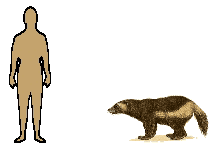Wolverine

| Class: Mammalia:
Mammals |
Diet: Mammals, small |
| Order:
Carnivora: Carnivores |
| Size: body:
65 - 87 cm (25 1/2 - 34 1/4 in), tail: 17 - 26 cm (6 1/2 - 10 in) |
| Family: Mustelidae:
Mustelids |
Conservation Status: Non-threatened
|
| Scientific Name:
Gulo gulo |
Habitat: coniferous
forest, tundra |
| Range: Scandinavia,
Siberia, Alaska, Canada, Northern U.S.A. |
 The
single species of wolverine is a heavily built animal, immensely strong
for its size and capable of killing animals larger than itself. Although
largely carnivorous, wolverines also feed on berries. They are solitary
animals, mainly ground-dwelling, but they can climb trees. Each male holds
a large territory with 2 or 3 females and mates in the summer. The female
wolverine bears 2 or 3 young in the following spring, usually after a period
of delayed implantation. Delayed implantation is an interesting phenomenon
allowing animals to mate at the ideal time and bear young at the ideal
time, even though the intervening period is longer than their actual gestation.
The fertilized egg remains in a suspended state in the womb, and development
starts only after the required period of dormancy. The young suckle for
about 2 months and remain with their mother for up to 2 years, at which
time they are driven out of her territory. They become sexually mature
at about 4 years of age. The
single species of wolverine is a heavily built animal, immensely strong
for its size and capable of killing animals larger than itself. Although
largely carnivorous, wolverines also feed on berries. They are solitary
animals, mainly ground-dwelling, but they can climb trees. Each male holds
a large territory with 2 or 3 females and mates in the summer. The female
wolverine bears 2 or 3 young in the following spring, usually after a period
of delayed implantation. Delayed implantation is an interesting phenomenon
allowing animals to mate at the ideal time and bear young at the ideal
time, even though the intervening period is longer than their actual gestation.
The fertilized egg remains in a suspended state in the womb, and development
starts only after the required period of dormancy. The young suckle for
about 2 months and remain with their mother for up to 2 years, at which
time they are driven out of her territory. They become sexually mature
at about 4 years of age.

 
|
